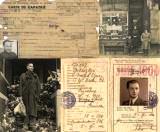New videos (only partially in English)
Summary, abstracts and full texts of issue no. 114
Philippe Mesnard (Editor in chief): Editorial: À propos de quelques lieux communs (pdf in French) (pdf in Dutch) [Concerning Some Commonplaces]
Dossier: Sites mémoriels [Memorial Sites]
Edited by Frediano Sessi (University of Mantoua)
With the collaboration of Carlo Saletti & Frédéric Crahay (Remembrance of Auschwitz)
Frediano Sessi (University of Mantoua): Présentation (pdf)
Sonia Combe (Institut des Sciences sociales du Politique, University of Paris Ouest Nanterre-La Défense): Le site mémoriel de Buchenwald (pdf) [The Buchenwald memorial site]
- The successive alterations of the transformation of the Buchenwald concentration camp into a museum, are not only an illustration of this constant “work in progress” that is history, but also its mutations. At Buchenwald, the changes do not reflect only a modification in public memorial practices. They show a change of perspective and a breakdown of interpretation. The deconstruction of museum policies that the Buchenwald camp endured in the early 1950s and in 1958, when the memorial was inaugurated, and finally in 1990 with the new design recommended by the Ministry of Science, research and the art of Thuringia, highlights the temporality of the issues that haunt such sites. It also leads to an interpretation of the various uses of the past, which generate conflicts of memory that should be considered for future revisions announced for the 70th anniversary of the camp's liberation in 2015.
- The author conducted a sociological-anthropological research on the Auschwitz museum at the end of 1989. The main lesson he drew from it was that the museum device of this institution professed, through antifascist propaganda, an occultation of the destruction of European Jews in the camp. This research was published, especially in no. 23 of the Bulletin of the Auschwitz Foundation. He returned to the museum after 23 years to see if, with the change of regime, the museum device had been changed.
Steffen Hänschen (Bildungswerk Stanislaw Hantz): Transforming remembrance in the former death camp Bełżec: a short history (pdf)
- The former death camp Bełżec has only a small place in the public memory on the Holocaust. During four decades the place has been nearly forgotten, since neither Polish officials nor the local inhabitants showed much interest in it. Only in the aftermath of the collapse of communism in 1989, the situation of the former death camp Bełżec began to change. In 2004 a new memorial complex was officially inaugurated as a branch of the state museum in Majdanek. For more than 8 years the museum and memorial in Bełżec are now active parts of the remembrance culture in Poland. But since the new memorial has been primarily constructed to preserve the mass graves as a cemetery, the transformation of the former camp into an educational place of significance is only a secondary goal. Nevertheless, the staff of the museum fosters historical education in the region of eastern Poland. This task is not easy to realize since Society’s opinion on the fate of the Jewish population remains divided.
Ivo Pejakovic (Jasenovac Memorial site): Jasenovac Memorial Site and “difficult heritage” (pdf)
- The article gives an overview of events that have influenced the changes and evolution of the Jasenovac Memorial Area, with an emphasis on the period of the last 20 years. Today, the museum is a place of remembrance of the victims and a place where young people shape their attitude, on the one hand toward the crime, and on the other hand toward the value of human life.
Roel Hijink (University of Amsterdam): Voormalig kamp Westerbork: Tussen reconstructie van de leegte en de herschepping van het kamp (pdf in Dutch) / L'ancien camp de Westerbork : Entre la reconstruction du vide et de la re-création du camp (pdf in French) [The former Westerbork camp: Between the reconstruction of the vacuum and the re-establishment of the camp]
- After the Hollandsche Schouwburg, the Anne Frank Huis and the Auschwitz monument in Amsterdam, the Herinneringscentrum Kamp Westerbork is the most important place in the Netherlands where the persecution and the destruction of the Jews is commemorated. The appearance of the area of the former camp of Westerbork dates from 1992. It looks like the landscape where grassy slopes have been made, sometimes lined with concrete building elements to show where the barracks stood. In and around the former camp are several memorials. There is almost nothing left of the original former Jewish transit camp. Earlier, they deliberately chose this symbolization because reconstruction was seen as kitsch. Now they want to transform the campsite because most of the visitors don’t regard it as a historical site. The only question left is how far the symbolic meaning can be stretched or transformed to reach a new visually-oriented generation without violating the integrity of the victims or profaning the place.
Frediano Sessi (University of Mantoua), Carlo Saletti: Le camp de Fossoli: Histoire et mémoire de la déportation d’Italie (pdf) [Camp Fossoli: History and Remembrance of the Deportation of Italy]
Isaac Gilead, Yoram Haimi (Archaeological Division, Ben-Gurion University of the Negev, Beer Sheva, Israel), Wojciech Mazurek (SUB TERRA, Archaeological Examinations, Chelm, Poland): Excavating Nazi Extermination Centres (pdf)
- The paper deals with the archaeology of the Nazi extermination centres at Chełmno, Treblinka, Sobibór and Bełżec. Aspects of sub-field identity are discussed first. The archaeology of extermination centres is the subject matter of a number of sub-disciplines, ranging from Forensic Archaeology, through Combat and Industrial Archaeology, to Public and Historical Archaeology. We regard the extermination process as a past reality, a series of historically established events which do not need to be proven by archaeological excavations. Archaeology, in our case, has the role of supplementing and filling gaps, especially in terms of sites’ layout, structures and artifacts. We describe the research of the extermination centres since the mid 1980s, discuss facets of site destruction processes, and emphasize the role of looting and other activities in determining the past and future layout and contents of the sites. These points are illustrated by some results of the archaeological research we carried out at Sobibór in 2007 and 2008. We indicate that the exact locations of important features of the extermination centres, for example gas chambers, are still unclear. Thus, archaeology is indispensable in reconstructing and preserving the physical layout of the extermination centres, as well as in studying and interpreting the artifacts embedded in their sediments.
Portfolio
Le Mémorial du Massacre de Nankin (pdf in French & Dutch) [The Nanjing Massacre Memorial]
Other
Bernard Krouck (Sciences Po Paris): De Tobrouk à Auschwitz: Les témoins de la Shoah (1942-1945) (pdf) [From Tobruk to Auschwitz: The witnesses of the Holocaust (1942-1945)]
Dorien Van De Mieroop (K.U. Leuven), Fransiska Louwagie (University of Leicester): Pronominagebruik en identiteit in Nederlandstalige deportatieverhalen uit het Breendonkcorpus (pdf) [Pronominal Usage and Identity Construction in Dutch-speaking Deportation Stories from the Breendonk Corpus]
- In this article, we study 18 interviews with witnesses who were deported from the fortress of Breendonk during the Second World War. In particular, we look into the way pronouns are used in these interviews and how they are related to the identity construction of the interviewees. After an initial quantitative analysis of the pronouns, we shift to a qualitative approach in which a contextualized analysis of these pronouns is executed. Next to the frequent occurrence of the first person pronominal form, reflecting the collective dimension of these interviews, there are also frequent changes in perspective, more specifically to the use of third person pronominal forms and the passive. These perspective shifts are indicative for the elements in the interviews that form a threat to the identity construction of the interviewees and they can thus be regarded as face saving strategies.
Bookhandel (pdf of Book reviews)
- Dominique Legallois, Yannick Malgauzou & Luc Vigier, L’accréditation des discours testimoniaux [Accreditation of testimonial speech], Toulouse, Éd. universitaires du Sud, 2011.
Review in French by Mylène Herry (University of Toulouse – Le Mirail) - Patrice Arnaud, Les STO: Histoire des Français requis en Allemagne nazie [The STO “Obligatory Work Service”: History of required French in Nazi Germany], Paris, CNRS, 2010.
Review in French by Hélène Camarade (University Michel de Montaigne – Bordeaux 3) - Fabrice d’Almeida, Ressources inhumaines: Les gardiens de camps de concentration et leurs loisirs [Inhuman resources: The guards of the concentration camps and their pleasures], Paris, Fayard, 2011.
Reviews in French by Frediano Sessi (University of Mantoua) and by Fabian Van Samang (Historian and Teacher at the Klein Seminarie, Roeselare) - Robert Belot, Klaus-Peter Sick, La Seconde Guerre mondiale pour les nuls [World War II for Dummies], Paris, Générales First, 2011.
Review in French by Anthony Michel (University of Lorraine) - Jean-Marc Berlière, Fichés?: Photographies et identification 1850-1960 [On file?: Photographs and identification 1850-1960], Paris, Perrin, 2011.
Review in French by Charles Futerman (AACCE – Paris) - Annette Wieviorka, L’heure d’exactitude [Time for accuracy], Paris, Albin Michel, 2011.
Review in French by Judith Lindenberg (EHESS) - Gabriele Andreozzi, Juicios por crímenes de lesa humanidad en Argentina, Buenos Aires, Cara o Ceca, 2011.
Review in French by Nadia Tahir (University Sorbonne Paris IV) - Michaël Prazan, Einsatzgruppen: Sur les traces des commandos de la mort nazis [Einsatzgruppen: In the footsteps of the Nazi death commandos], Paris, Seuil, 2010.
Review in French by Frediano Sessi (University of Mantoua) - Jacques Semelin, Face au totalitarisme: La résistance civile [Face of totalitarianism: Civil Resistance], Brussels, André Versaille, 2011.
Review in French by Hélène Camarade (University Michel de Montaigne – Bordeaux 3) - Hans Keilson, La Mort de l’adversaire [The Death of the Adversary], Paris, Seuil, 2012.
Review in French by Aurelia Kalisky (Zentrum für Literatur und Kulturforschung – Berlin)
Some of our projects
Contact
Auschwitz Foundation – Remembrance of Auschwitz
Rue aux Laines 17 box 50 – B-1000 Brussels +32 (0)2 512 79 98
+32 (0)2 512 79 98 info@auschwitz.be
info@auschwitz.be
BCE/KBO Auschwitz Foundation: 0876787354
BCE/KBO Remembrance of Auschwitz: 0420667323
Office open from Monday to Friday 9:30am to 4:30pm.
Visit only by appointment.
![]()
![]()
![]()
![]()
![]()
Become a member
To become a member of Remembrance of Auschwitz ASBL, please contact us and transfer the sum of €50.00 to our account IBAN: BE55 3100 7805 1744 – BIC: BBRUBEBB with the communication: ‘Membership fee 2025’. The membership includes two issues of 2025 of our scientific journal.
DONATIONS
Donations of €40.00 or more (in one or more instalments) qualify for tax exemption for Belgian taxpayers.
In communication, please specify that it is a ‘Donation’ and mention your National Number which is required since 2024 to benefit from the tax exemption.
Subscribe
Error : Please select some lists in your AcyMailing module configuration for the field "Automatically subscribe to" and make sure the selected lists are enabled










 The Auschwitz Foundation was founded in 1980 by Paul Halter, an Auschwitz survivor. Replacing the Amicale Belge des Ex-Prisonniers politiques d’Auschwitz-Birkenau Camps et Prisons de Silésie, the primary objective of the Auschwitz Foundation is to study the history and memory of the victims of the Holocaust and the Nazi terror in a sustainable and systematic way. The transmission of memory and the preservation of archives concerning these events complete this goal.
The Auschwitz Foundation was founded in 1980 by Paul Halter, an Auschwitz survivor. Replacing the Amicale Belge des Ex-Prisonniers politiques d’Auschwitz-Birkenau Camps et Prisons de Silésie, the primary objective of the Auschwitz Foundation is to study the history and memory of the victims of the Holocaust and the Nazi terror in a sustainable and systematic way. The transmission of memory and the preservation of archives concerning these events complete this goal.





